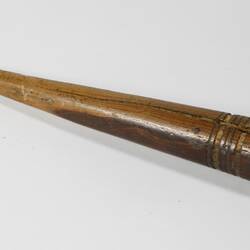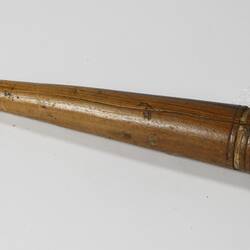Summary
Used for sailmaking.
"It is kept hanging in a rack, or in one of the holes in the sailmaker's bench, to avoid becoming scratched, for a smooth surface is essential. It is used for stretching holes in canvas, and for stretching and sizing rope grommets and cringles, sometimes in order to admit a metal thimble. Grommets are rope rings to which the edge of a purpose-made hole in the sail is sewn. Cringles are eyelets formed of rope loops fitted over the bolt ropes (the ropes sewn round the edges of the sail). Hand fids are also used for opening the lay in ropes when splicing." [Ref: Dictionary of Tools used in the woodworking and allied trades, c1700-1970, by R. A. Salaman, 1975, pp402-403]
Physical Description
Round, tapered piece of wood. Tool is cracked along its length.
Significance
This object is part of a collection of hand tools and materials, related to the trades of shipwrighting and sailmaking. Shipwrights and sailmakers were a very important trade for the construction and maintenance of water transport, such as paddlesteamers and sailing ships. The early colony of Victoria relied on the skills of these trades for construction of new vessels as well as their ongoing maintenance.
There are close to 7000 objects, documents and images related to the Trades Collection, which is primarily a collection of the tools associated with various trades, such as baking, blacksmithing, bookbinding, boot & shoe making, bricklaying, broom making, butchering, carpentry & woodworking, coachbuilding & wheelwrighting, coopering, coppersmithing, drafting, founding & moulding, gardening, glazing, hairdressing, hat making & millinery, jewellery making, knife & blade sharpening, leatherworking, metal working, organ building, painting & decorating, patternmaking, plumbing, printing, saddlery, shipwrighting, stonemasonery, tailoring & dressmaking, tiling, tinsmithing, tool making, undertaking, upholstering, wig making, and woodturning.
More Information
-
Collecting Areas
-
Acquisition Information
Unknown Acquisition Method from Unknown Source, Before 04 Jan 1991
-
Date Used
-
Classification
-
Category
-
Discipline
-
Type of item
-
Overall Dimensions
235 mm (Length), 30 mm (Outside Diameter)
-
References
Dictionary of Tools used in the woodworking and allied trades, c1700-1970, by R. A. Salaman, 1975, pp402-403
-
Keywords


